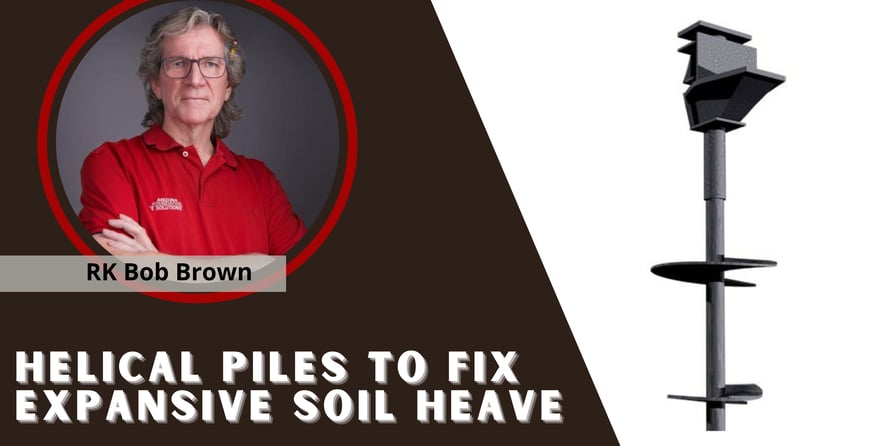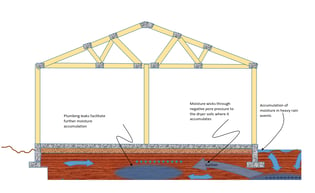Helical Piles to Fix Expansive Soil Heave…. Round Pegs for Square Holes!
Recently I read on a foundation repair competitor’s blog that their solution to foundation heave was - wait for it- more helical or push plies. They of course mischaracterize our MoistureLevel Smart Foundation System as blowing air over the soil under the foundation and their comment “good luck with that!”.
Not only do they mischaracterize it but they also imply that it is on par with hiring an ‘Indian Rain Dancer’. Let’s discuss the merits of soil venting technology and then the problem with helical piles alleviating expansive soil heave.
Many contractors that don’t understand soil venting technology (or don’t want to understand it) and say that we are blowing air over the soils under the house using a fan. It is true the vacuum unit that we use to create a sub-slab depressurization zone under a foundation is often referred to as a fan. The only thing that it is blowing is the exhaust out above the home. As mentioned previously, its function is to create a vacuum field under foundation (which can be measured with a mirco-digital manometer), in order to a create flow of dry air over moist soils. As dry air flows over moist soils it picks up the moisture and transports it to the exhaust system and then out and away from beneath the structure’s foundation.
Using helical or push piles to fix an expansive soil heave problem is a bone headed idea!
This technology has been well established in the environmental engineering community for many years. In fact, the EPA publishes a Citizens Guide to soil vapor extraction. No really… check it out here: https://semspub.epa.gov/work/HQ/189976.pdf . A quick Google Search for soil venting returns a plethora of peer reviewed papers and discussions that establish this as a confirmed scientific process for venting chemicals and moisture from soils.
The picture below shows how a similar system (Radon extraction) blows moist air out the exhaust consistently creating black mold on the surface it exhausts to. It’s not an uncommon problem with improper installations. So if it does not work as some local competitors claim, what's with the mold localized at the exhaust exit?
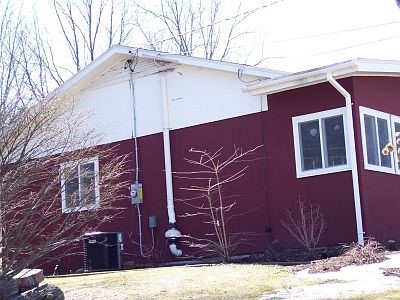 We regularly measure the amount of moisture exhausted using an anemometer (a device used to measure moisture in the air). We can calculate the amount of moisture being removed each day using a psychrometric chart. The average amount removed in the MoistureLevel Smart Foundation Systems measured in the last few years has been a whopping 62 lbs (approx. 8 gallons) of water each day!
We regularly measure the amount of moisture exhausted using an anemometer (a device used to measure moisture in the air). We can calculate the amount of moisture being removed each day using a psychrometric chart. The average amount removed in the MoistureLevel Smart Foundation Systems measured in the last few years has been a whopping 62 lbs (approx. 8 gallons) of water each day!
If we are removing that much moisture, the soil it is coming from is losing that moisture. If we are removing moisture from clays they cease to expand and, in many cases, even shrink back. Thus, solving the problem of expansive soil heave. We can also look at the proof in the pudding…. a dome heave is made flatter with this technology. See the diagram below from a recent home that we measured.
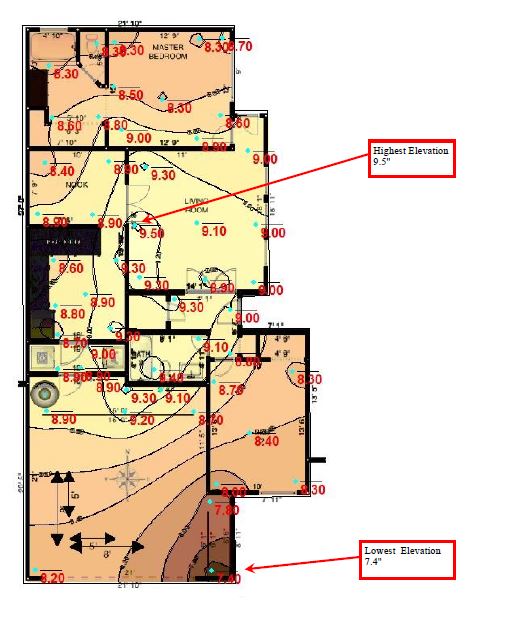
In the above topo survey taken in Feb of 2018, the highest area is in the middle area of 9.5”.
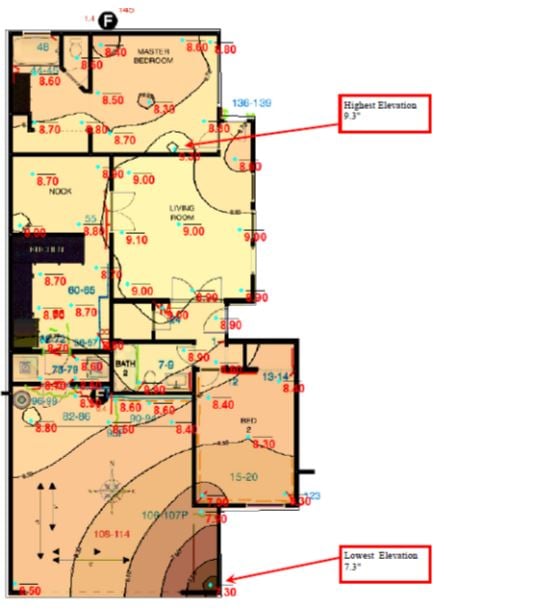
The above topo survey was taken 3 years later in Feb of 2021. It’s hard to see a whole lot of difference except that it seems a bit flatter.
What we have been able to do with this data is perform a subtractive manometer. We take the elevations of the second reading and subtract them from the numerical readings from the one taken 3 years earlier. With these new values we plot a new topographical map. It essentially graphically shows how the slab moved over the 3-year period of time.
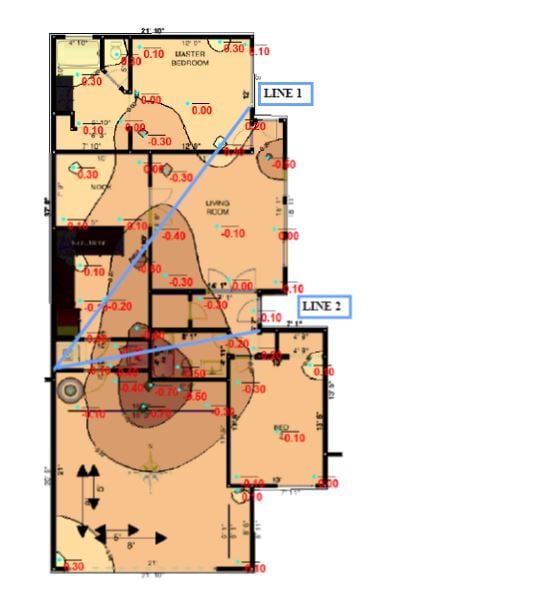
You can see that it shows a low spot in the middle. It’s important to realize that the above is not a representation of the slab. That data is represented in the 2nd diagram of Feb 2021. However, we can look at the first reading of Feb 2018 that shows a high spot in the middle. This is a classic dome heave and look at the subtractive (how it moved over time). Note that it shows a lowering over a 3-year period, a distinct lowering in the middle area…. the same area that was high originally.
The above analysis is not untypical for homes that we install the MoistureLevel Smart Foundation System in. This is just a recent example.
Now, let’s evaluate the claim that heave can be repaired with helical or push piles. Let's take a look at the diagram below:
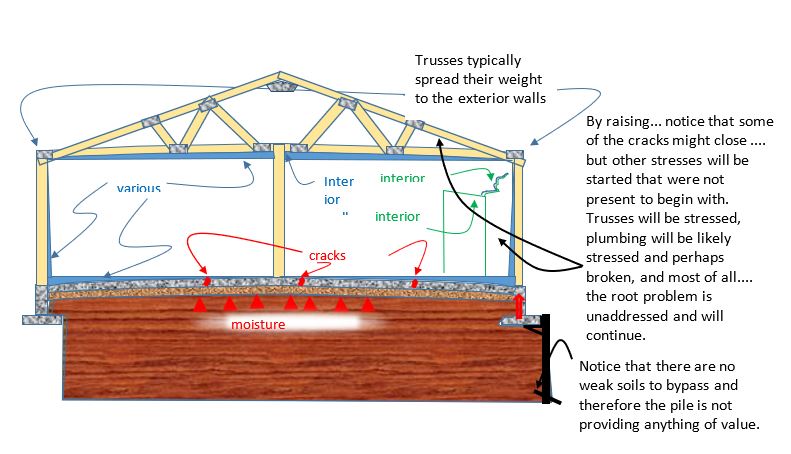
In the above representation of a home with foundation heave in the middle area, you can see how the slab is high in the middle - like the first topo reading of Feb 2018. If we understand this depiction, we then realize that the original position of the footings has not moved. Only the middle slab which is not connected to the footings has moved. If we try to underpin and raise the footings we can cause misalignment with the floor slab and it puts stress on the trusses (they are attempted to be raised to a position that they have never been to and were not designed to be at).
Knowing all of this, it becomes obvious that using helical or push piles to fix expansive heave problem is a bone headed idea! It is expensive, does no good, and could cause serious harm to a home.
There you have it. Just because someone makes a claim on the internet, does not mean it is true. I invite discussion and verification of any of our claims made here; we have the science and data to support the success of this patented foundation heave remediation solution. The MositureLevel Smart Foundation System is one of our patented foundation repair solutions and is only available in Arizona with Arizona Foundation Solutions.
In the end the truth comes out.


